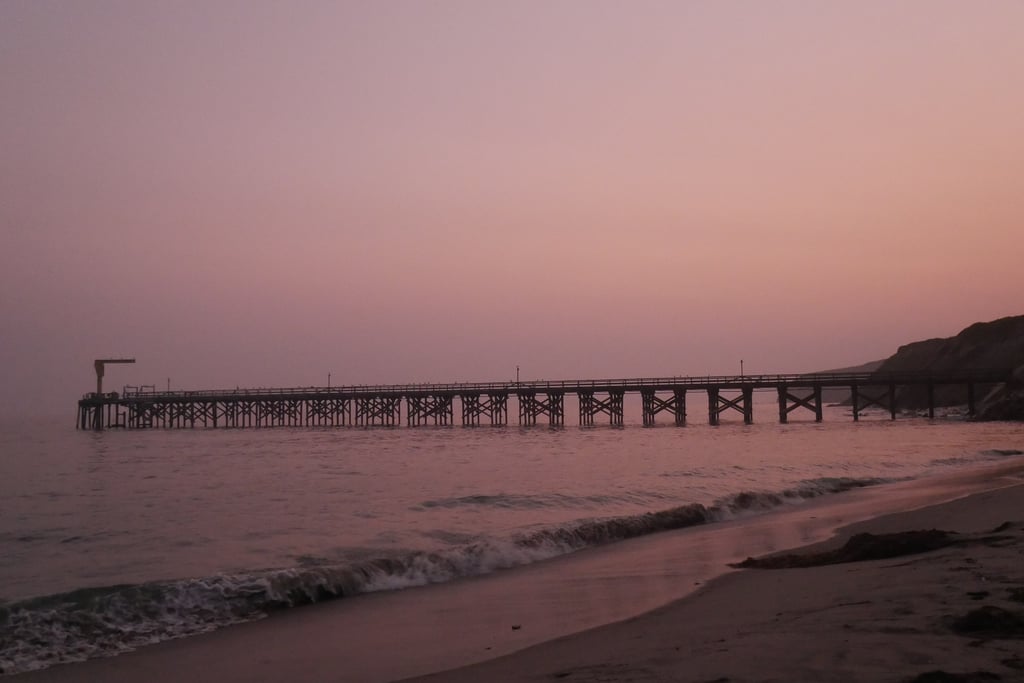The sign at the top of the hill told me to turn around. I was entering private property, and not welcome.
Probably for the best, I thought, pulling up my drenched shirt to wipe off sweat. A pampered runner, I prefer using the flat treadmill in my temperature-controlled house while watching soccer. The hills on the cliffside road where Gaviota State Park meets Hollister Ranch had almost defeated me.
Were I not struggling for breath I might have cared about being told to stay out of a beautiful stretch of California coastline.
Alas, the owners of multimillion-dollar houses in the ranch have property rights, and they can exclude the hoi polloi if they like.

But thanks to the California Coastal Commission, they can’t keep us away from the state’s many beaches, all of which are public up to the mean high tide line.
Composed of six members of the general public and six elected officials from coastal districts, all appointed, as well as three non-voting members, the commission that was first established by voter initiative in 1972 governs coastal land-use decisions and is tasked with protecting coastal resources, managing commercial fisheries, industry and water usage and ensuring the public can access the coastline.
Inspired in part by plans to develop 10 miles of pristine Sonoma County coastline into a community called Sea Ranch, the group has made waves in recent years.
In 2018, the U.S. Supreme Court rejected a lawsuit by billionaire Vinod Khosla that would have made California pay $30 million for an easement to let the public access Martins Beach in San Mateo County.
The commission hopes to prevail in state court litigation against Khosla based on past use under previous owners. If they do, the commissioners plan on ordering Khosla to dismantle gates he has erected or face fines. If they don’t, the state is working on a backup plan to pay $2 million to create the passageway through eminent domain.
Hotel owners have also run afoul of the agency, racking up fines for unpermitted construction and blocking public access. Municipalities have enacted laws to ensure compliance.
A couple in Malibu sued the city in 2018 for prohibiting signs that claimed to identify the boundary between public beaches and private property.
Represented by the Pacific Legal Foundation, Dennis and Leah Seider argued the law violated their First Amendment Rights to free speech by preventing them from lawfully demarcating their property line. Though the ordinance seeks to enforce Coastal Commission regulations, the couple did not name the agency as a defendant.
Perhaps the biggest access battle in recent years has been with the owners at Hollister Ranch, tucked into in the remote western corner of Santa Barbara County.
One of the few remaining undeveloped portions of coastline in Southern California, the ranch had been home to native tribes including the Chumash people. A Spanish expedition traveled through in 1769. William Welles Hollister bought the land after the Civil War, lending the area its name.
Ranching continues in some parts of the community. Though arguably uneconomical, ranching reduces fuel for wildfires and provides tax benefits to owners.
Beaches dot the shoreline beyond sometimes towering cliffs. Getting there has never been easy, but the recent loss of a crumbling boat launch at adjacent Gaviota State Park has made access more difficult.

In 2019, California Governor Gavin Newsom signed a bill amending the Coastal Act that required the commission come up with a new public access program for the ranch by 2022.
Hollister Ranch Owners’ Association president Monte Ward told Courthouse News in June 2020 the group is focused on working with state agencies to develop the plan.
Ward did not reply to a request for comment after a federal judge dismissed a lawsuit filed by his group that claimed the bill trampled their property rights. The group’s attorney, also with the Pacific Legal Foundation, filed a motion asking the court to allow for future challenges to the law but withdrew it before a July court hearing.
Many Californians, this adopted son among them, cherish the right to visit our beaches. The hope is that doing so will imbue residents with a sense of ownership of our precious resources and promote conservation, exactly what Hollister Ranch owners have long maintained they are doing by keeping the public out of their enclave.
Arguably little more than a highfalutin justification to let in only the few desirables who can afford multimillion-dollar properties, anybody who has visited a busy beach after a typical summer weekend knows the waste we the public often leave behind.
Past stewardship and property rights are important, but in California, the law is clear. The beaches belong to the people.
And even during a pandemic our coastline attracts visitors not only from other parts of the state but around the world.

The campground at Gaviota State Park was full on the Monday and Tuesday nights I spent there recently. While a few groups set out for backcountry hiking trails that abut Hollister Ranch, the path to which is highlighted by rolling hills and graffitied structures and frequented by mountain lions, the majority stuck to the small but majestic beach.
One visitor told fellow campers she had been taking camping trips there for more than 20 years. A family from Spain stopped over in their rented RV. Their teenage daughter swam in the cool ocean while her father sat on the beach. A couple from Germany commented on the impressive train trestle that spans the beach, over which the Amtrak makes frequent runs. A group of young people from China took pictures of each other.
Meanwhile, I enjoyed a purple sunset, accompanied by a curious seagull — another glorious end to a day on one of California’s public beaches.
Subscribe to our columns
Want new op-eds sent directly to your inbox? Subscribe below!

















